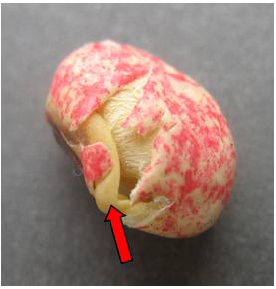- Germination begins with imbibition (absorbing water) followed by the development of the radicle (primary root) and emergence of the cotyledons (seed leaves).
- Planting into a moist seedbed with good seed-to-soil contact is important for optimal germination.
- Dry or flooded soils, compaction, and cool temperatures are conditions that can hinder soybean germination and emergence.
The Germination and Emergence Process
After planting, a soybean seed will start to absorb or imbibe water, resulting in a change in moisture content from less than 13% to almost 50% in several hours. Within one or two days under favorable temperatures, the first root (radicle) of the swollen seed will emerge through the seed coat (Figure 1) and grow downward to develop the primary root. Lateral roots quickly emerge from the radicle as it elongates and root hairs grow from the radicle and the lateral roots. The root hairs become the main absorbing structures.

Five to ten days after planting, the new seedling emerges from below the soil surface representing the vegetative emergence (VE) stage of growth. The hypocotyl begins to elongate and forms a hook that pushes through the soil surface, pulling the cotyledons upward (Figure 2). The cotyledons serve as a temporary source of stored food for the seedling. Shortly after emergence, they open and turn green due to exposure to sunlight and start making additional food through photosynthesis. As the cotyledons open, the epicotyl is revealed. The epicotyl contains small leaves, buds, and the main growing point.

The unifoliate leaves appear next representing the VC stage of growth (Figure 3). The unifoliate leaves are single, non-compound leaves that emerge simultaneously and on opposite sides of the stem. Following the unifoliate leaves, the trifoliate leaf appears, the first true leaf of the soybean plant, representing the V1 stage (Figure 4). The trifoliate leaves are compound leaves made up of three leaflets and emerge one at a time, alternating on opposite sides of the stem. The next trifoliate leaf to appear represents the V2 stage, with each new trifoliate leaf representing a new V stage.



Moisture. Planting into a moist seedbed with good seed-to-soil contact is necessary for optimal germination as moisture needs to move into the seed for germination to occur. If irrigation is required for adequate soil moisture, it should be applied ahead of soybean planting and not immediately after planting. Planting into dry soil with rainfall or irrigation occurring too soon after can result in soil crusting and poor soybean emergence.
Soil Conditions. Soil crusting can delay or prevent seedling emergence and cause soybean hypocotyls to become swollen or break when trying to push through the crust. When the hypocotyl breaks, the seedling usually dies. Fields with fine-textured soils, low organic matter, and little surface residue can be vulnerable to crusting, especially where excessive tillage has taken place.
Temperature. Soybean seed can begin to germinate when soil temperatures are less than 55 °F; however, germination is likely to be slow until soil temperatures warm to the upper 70s. Cold soil temperatures can cause seeds to remain dormant, increasing their vulnerability to seed and seedling diseases and feeding by insects and wildlife. When soil temperatures are between 70 ºF and 90 ºF, seedling emergence should occur in less than a week. Soil temperatures above 95 ºF can also cause poor soybean germination and emergence resulting in reduced stands.
Oxygen. Because seed respiration increases during the germination process, saturated, flooded, and compacted soils can reduce germination and emergence due to a lack of oxygen. Soil pore spaces that are filled with water have reduced oxygen available for seed respiration. Compacted soil reduces the availability of water and oxygen required for germination, root and plant growth, and nutrient uptake.
Sources
Soybean as a crop. Modern corn and soybean production. MCSP, http://www.mcsppubs .com Hoeft, R.G., Nafziger, E.D., Johnson, R.R., and Aldrich, S.A. 2000. Modern corn and soybean production. First edition. MCSP Publications. Champaign, IL. Pedersen, P. 2007. Soybean growth stages. Soybean growth & development. PM 1945. Soybean Extension and Research Program. Iowa State University. http://extension.agron.iastate.edu Pedersen, P. Soybean planting date. Iowa State University. http://extension.agron.iastate.edu Web sources verified: 4/16/15. 140513060107
